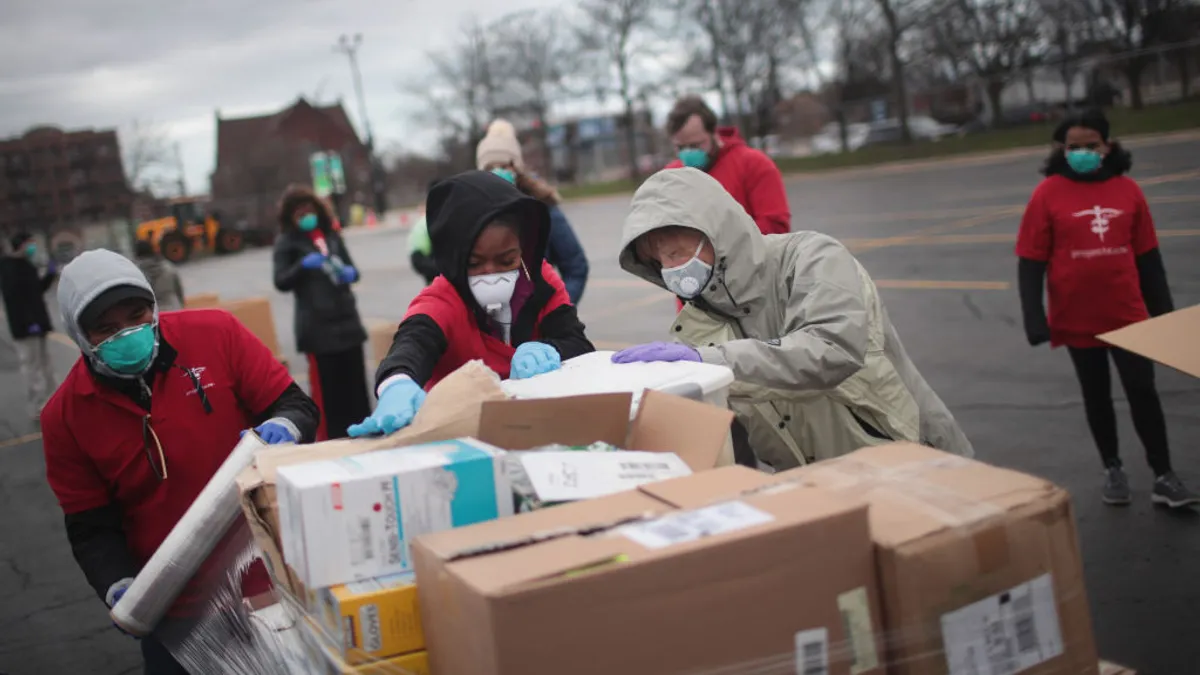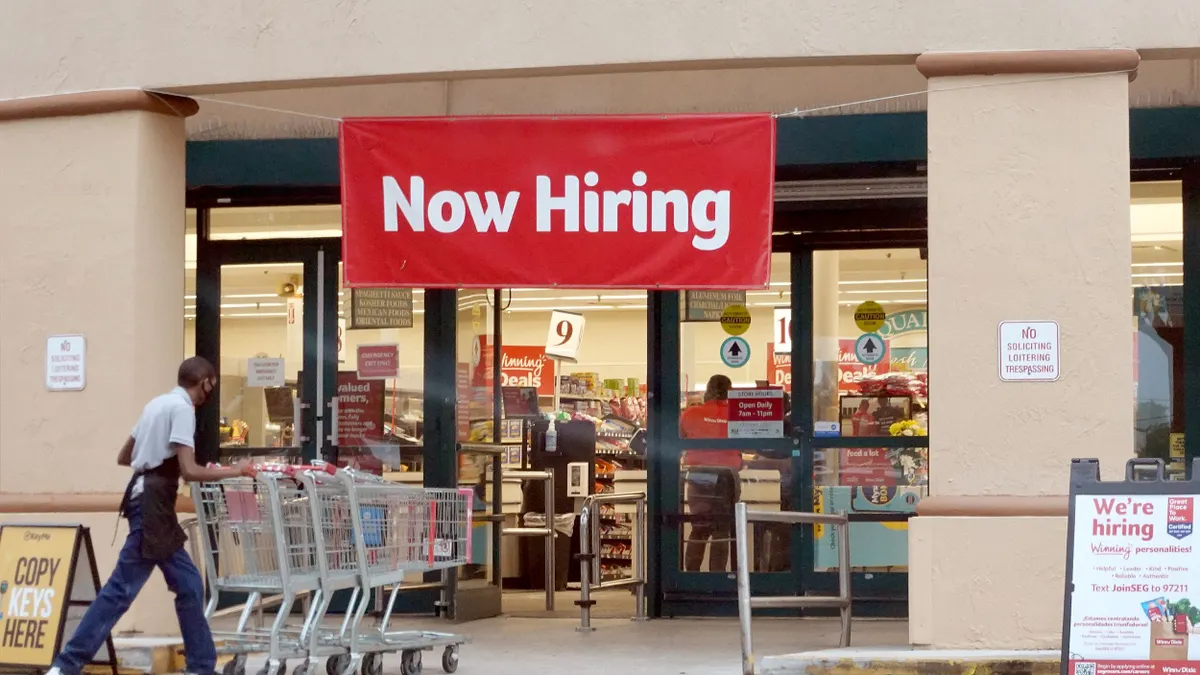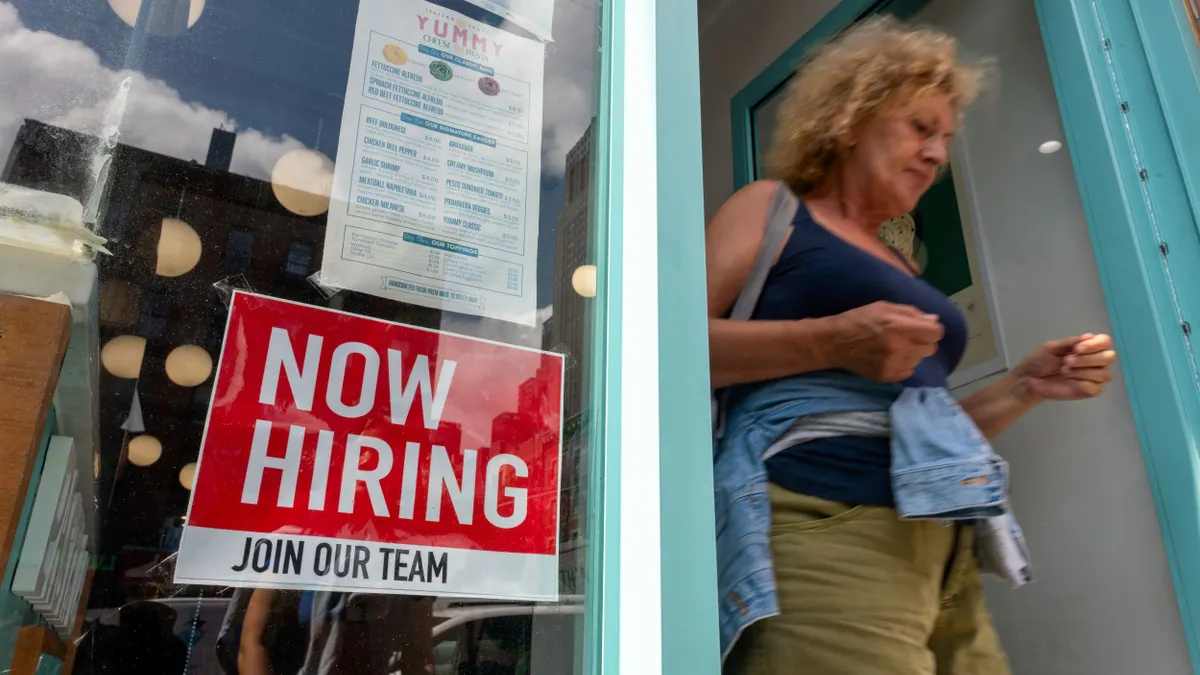2020 posed numerous challenges for workers, but research shows it also may be bringing them closer to their communities.
For example, the United Nations has observed a "global surge" in volunteerism during the pandemic, particularly in European countries, according to an article. Echoing a similar theme, LinkedIn's Economic Graph team found that, as of August 2020, LinkedIn members in the U.S. added more than 110,000 volunteer experiences and activities to their profiles per month, a rate that represented a 2.5 times increase compared to 2017's monthly count, per the site.
For many workplaces, however, work now looks different than it did pre-pandemic, thanks in part to the rise of both remote work and hybrid work. That has sparked interest among employers as to how they can encourage volunteerism as employees continue work outside shared offices, according to Amy Mosher, chief people officer at human capital management platform iSolved.
In an interview with HR Dive, Mosher discussed iSolved's recent acquisition of Givful, a workplace philanthropy platform, and how iSolved has used the solution internally to enable both giving and volunteerism in a hybrid workforce. Mosher also discussed how hybrid work has changed the types of causes and activities in which employees participate.
Editor's note: This interview has been edited for clarity and brevity.
HR DIVE: How has the workflow at iSolved changed in the past year? How early on did you adopt a hybrid work approach?
Amy Mosher: Well, we've always been a very flexible culture with a flexible work model. In fact, prior to the pandemic, 50% of our employees were remote, and we worked out of seven to nine offices over the last couple of years across the country. So we've had a disparate workforce all along. That is not something that was new for us.
Moving everyone into a remote environment was of course a challenge, logistically. But given we already had managers and employees who had a comfort level with working remotely, it was a more effective process that I think a lot of companies endorsed during that period. We also have software, so all of our employees, for the most part, had access to laptops already. They already had internet. They were well suited to remote environments. We still did run some operations — we still print checks and things like that, [and] we still work on time clocks as a small part of our business — so we did have individuals that we deemed as essential workers that were still on site in most of our office locations, and those folks worked on site throughout the pandemic. We had to also be flexible enough with our policies and programs ... because we still did have those essential employees on site.
For us, we also grew significantly as an organization during the pandemic, both organically and inorganically. We were able to leverage a market where many companies were having a difficult time with the changes in revenue dynamic. We also implemented a new executive team, and there's a lot of change there that happened at the same time, including myself coming on board right before the pandemic. And so there was trust and change management, a lot of additional communication and culture building that we [did] during that time.
And I see that, as you implemented this sort of approach, you had some chances to change things during the pandemic, as far as workflows and how teams are interacting.
Yes, we continue to experiment with that. We're very fortunate that through functionality within our system, we have a social dynamic that's created by that product within the business that allows us to be more nimble and communicative in remote environments.
You've got kind of a social aspect of that integrated intranet with new library capabilities, the automated workflow for performance management and goal setting, and that ongoing social communication as well — which includes the giving and volunteering platform — so that we can stay connected with employees across our business. So regardless as to whether the pandemic has happened or not, for us this last couple of years, we would still have had those challenges. And I think [we] also navigate them more effectively as a result of having that access to a hub of information that includes workflow, approval processes, campaigns, open communication and knowledge management. So, that made it very seamless for us to move into a remote environment for all of our employees.
Speaking of the volunteering platform initiative, why was it important for iSolved to emphasize this?
It is essential, I think in today's environment, and especially in [today's] socioeconomic times. I feel like employees want to give back. They understand, as a result of going through this difficult time, how important it is to give back to people who need it. I feel like this giving and volunteering platform allows employees to give where they feel is needed. It gives them a lot more opportunity. They have access, via the platform, [to] every not-for-profit available in the database. You can build campaigns around certain not-for-profit types or associations, specific associations, matching programs. It's very easy to give money, but it's also very easy to give time in the scheduling and campaign part of that platform.
Having everyone be very disparate from a geographic perspective lends itself to [a] more difficult process of getting people together. Prior to the pandemic, we would [describe] giving and volunteering as being about bringing people together to volunteer their time and build a house, and they get a t-shirt, right? It's a kind of traditional giving and volunteering thought. But when you really think about this, we've been able to continue to do that. We still give out the t-shirts, we still have a time volunteer program at iSolved where you get paid to volunteer your time. But through a platform like this, you're really enabling your entire population to have the same access to the opportunity to give back to their communities. It's not just the people that are in a certain office, or the offices that are near the Feeding America food closet. Every single employee has an opportunity to give in their own community, and that breeds inclusion, which is key to culture.
Just to be clear, you've seen that feature being used internally, right?
Yeah, absolutely. We're very lucky that we already have a very inclusive culture. We've got a huge diversity and inclusion effort that our employees within the organization run. And this feeds right into that as well. We can give back to not-for-profit associations that also align to our D&I vision for the organization that our employees develop and manage. It's a terrific enhancement for that. But we've also seen an increase in the amount of volunteering, just because it's so easy, and because they can volunteer and give back locally to the not-for-profit association that's in their neighborhood.
What kinds of causes or organizations, or even movements, are people getting involved in?
The trend that we're seeing today is more local. Previously, from an administrative perspective, because of the complexity of administering a giving and volunteering program, you would have seen more national efforts. Feeding America is a good example of that ... the American Way, the American Cancer Society ... the bigger associations and organizations that you do campaigns around. Now, it's about how can you give back to your local food closet? How can you give back to your local mental health association or your local pride organization or your local Veterans Association? That's pretty cool.
So I think we're making a bigger impact for a lot of different causes, whereas previously, it would have been more centralized, which again, just brings that inclusion, and people feel good about helping in their local communities.
How have iSolved's management and leaders encouraged volunteerism?
We have a program that allows employees to volunteer eight hours a year, and there's no approval process for that. They just let their supervisor know that they're going to volunteer and they go out there and they're paid for that day. We also have a lot of flexibility within our work time. Most of our employees are exempt employees. We have a flexible work schedule. We allow our employees to take a few hours off to do what they feel is right; if they need to get up at three to go to the food closet, they don't have to take PTO for that. And it's really ingrained in our culture. We're a culture of inclusion and giving, and we do that by making it clear at the top level — our managers and executives are making it clear that this is just as important as any other initiative for the organization. Your ability to feel good and get back is as important as your performance on the job.
"Every single employee has an opportunity to give in their own community, and that breeds inclusion, which is key to culture."

Amy Mosher
Chief People Officer, iSolved
I feel confident that, if I ask any employee whether they feel comfortable taking time off to volunteer, the majority would say yes. And that is supported by our management teams. Of course, we have busy seasons, busy times and busy days of the week, busy times of the month and quarter, and we have to manage around the business needs of that. But I think it's very positive and very appreciated, actually, by our management that our employees get involved in their local communities. We're looking for people that share that value as well. So as we bring new employees into the business, and we share with them how important that is to our culture, we breed more of that within our business by hiring people [who] share those same values. So I think it is reciprocating right throughout the business when you do that.
Have you noticed any other changes to the types of volunteering that people do?
I think there's a couple of trends that we're seeing in giving and volunteering. One is towards giving and volunteering time and money to mental health and organizations that support mental health. I think that's a huge trend and something that we're seeing, as kind of under the microscope from a societal perspective, but we're also seeing a lot more employees that are interested in giving their time to peer availability projects or suicide hotlines, because you can do that from home. I think you're seeing more of that kind of individual time giving back as opposed to group activities. And then you're also seeing the emphasis on wellness as a whole. It could be something like an employee volunteers their time to teach teens at the YMCA how to do group meditations, for example. There's so many of those things that are coming up now that you never would have thought of two years ago around that whole mental health and education process. We see employees getting a lot more involved in that.






















